Review Mitosis by Matching Each of the Phases of Mitosis to the Corresponding Pictures
7.3: Mitotic Phase - Mitosis and Cytokinesis
- Page ID
- 16755
Tin can you guess what this colorful image represents? Information technology shows a eukaryotic cell during the process of cell division. In particular, the image shows the nucleus of the jail cell dividing. In eukaryotic cells, the nucleus divides before the cell itself splits in ii; and earlier the nucleus divides, the cell's DNA is replicated, or copied. At that place must be two copies of the Deoxyribonucleic acid so that each daughter jail cell volition accept a complete copy of the genetic material from the parent jail cell. How is the replicated DNA sorted and separated and so that each daughter jail cell gets a consummate fix of genetic material? To answer that question, you first need to know more than almost Deoxyribonucleic acid and the forms information technology takes.
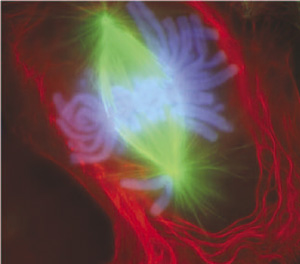
The Forms of DNA
Except when a eukaryotic cell divides, its nuclear Dna exists as a grainy material called chromatin. Only when a cell is about to divide and its DNA has replicated does DNA condense and roll into the familiar X-shaped form of a chromosome, like the 1 shown in Figure \(\PageIndex{2}\). Because Dna has already replicated, each chromosome actually consists of ii identical copies. The two copies of a chromosome are called sis chromatids. Sister chromatids are joined together at a region chosen a centromere.

The process in which the nucleus of a eukaryotic cell divides is called mitosis. During mitosis, the two sister chromatids that make up each chromosome dissever from each other and move to reverse poles of the cell. Mitosis occurs in iv phases. The phases are called prophase, metaphase, anaphase, and telophase. They are shown in Figure \(\PageIndex{three}\) and described in item below.
Prophase
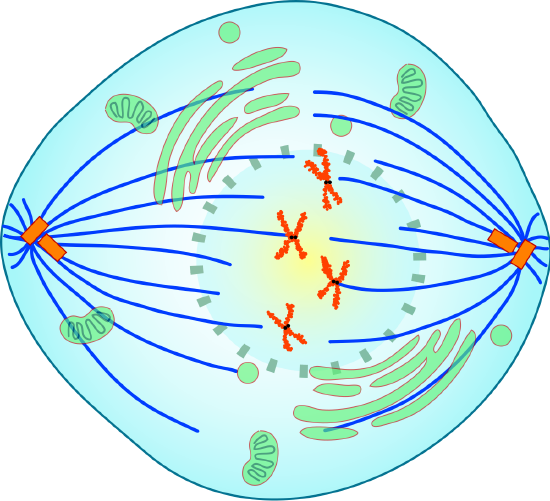
Figure \(\PageIndex{4}\): Prophase in later stage is chosen prometaphase. The spindle starts to form during the prophase of mitosis. The spindles first to attach to the Kinetochores of centromeres of sister chromatids during Prometaphase.
The outset and longest phase of mitosis is prophase. During prophase, chromatin condenses into chromosomes, and the nuclear envelope (the membrane surrounding the nucleus) breaks down. In animal cells, the centrioles nearly the nucleus begin to separate and move to opposite poles of the jail cell. Centrioles are minor organelles plant simply in eukaryotic cells that help ensure the new cells that form later on cell division each contain a complete set of chromosomes. Equally the centrioles motility apart, a spindle starts to course betwixt them. The blue spindle, shown in Figure \(\PageIndex{4}\), consists of fibers made of microtubules.
Metaphase
During metaphase, spindle fibers fully attach to the centromere of each pair of sister chromatids. As you tin see in Figure \(\PageIndex{5}\), the sister chromatids line up at the equator, or centre, of the cell. The spindle fibers ensure that sister chromatids will separate and go to unlike daughter cells when the cell divides. Some spindles practice not attach to the kinetochore protein of the centromeres. These spindles are called not-kinetochore spindles that help in the elongation of the cell. This is visible in Figure \(\PageIndex{5}\).
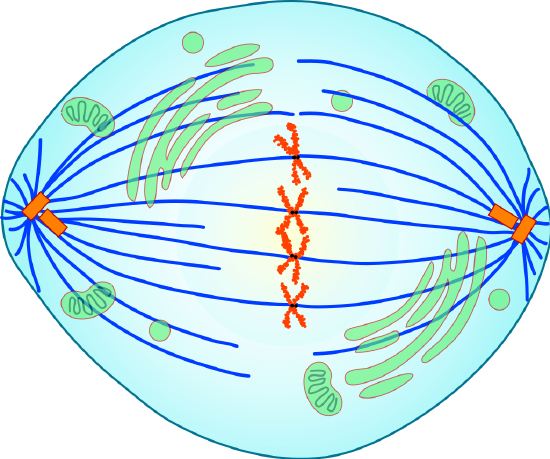
Anaphase
During anaphase, sister chromatids separate and the centromeres divide. The sister chromatids are pulled apart by the shortening of the spindle fibers. This is a little similar reeling in a fish by shortening the fishing line. I sister chromatid moves to one pole of the cell, and the other sister chromatid moves to the opposite pole (meet Figure \(\PageIndex{6}\)). At the end of anaphase, each pole of the prison cell has a consummate set of chromosomes
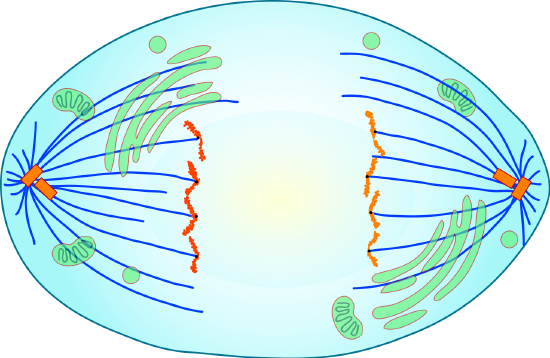
Telophase
The chromosomes reach the opposite poles and begin to decondense (unravel), relaxing once over again into a stretched-out chromatin configuration. The mitotic spindles are depolymerized into tubulin monomers that will exist used to gather cytoskeletal components for each daughter cell. Nuclear envelopes form around the chromosomes, and nucleosomes announced within the nuclear area (see Figure \(\PageIndex{seven}\).
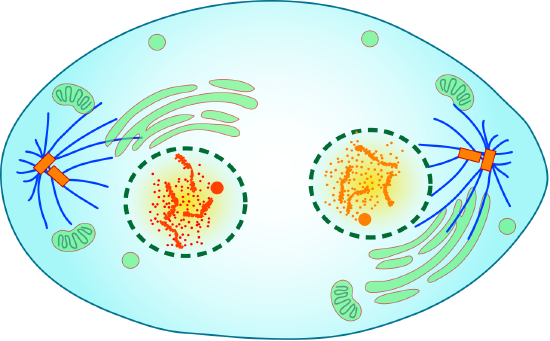
Cytokinesis
Cytokinesis is the concluding phase of cell division in eukaryotes as well as prokaryotes. During cytokinesis, the cytoplasm splits in 2 and the cell divides. The process is different in plant and fauna cells, as you can see in Effigy \(\PageIndex{eight}\). In animal cells, the plasma membrane of the parent cell pinches inward along the prison cell'south equator until two daughter cells form. In the plant cells, a prison cell plate forms forth the equator of the parent cell. Then, a new plasma membrane and cell wall form forth each side of the cell plate.

Review
- Describe the dissimilar forms that DNA takes before and during cell division in a eukaryotic cell.
- Place the four phases of mitosis in an animate being cell, and summarize what happens during each phase.
- Explain what happens during cytokinesis in an animal jail cell.
- What are the chief differences betwixt mitosis and cytokinesis?
- The familiar Ten-shaped chromosome represents:
- How Dna always looks in eukaryotic cells
- How DNA in eukaryotic cells looks one time information technology is replicated and the cell is about to divide
- Female sex chromosomes but
- How Deoxyribonucleic acid appears immediately after cytokinesis
- Which of the post-obit is not part of a chromosome in eukaryotic cells?
- Centriole
- Centromere
- Chromatid
- DNA
- What do you think would happen if the sis chromatids of one of the chromosomes did not separate during mitosis?
- Put the post-obit processes in gild of when they occur during cell division, from first to terminal:
- separation of sister chromatids
- DNA replication
- cytokinesis
- lining up of chromosomes in the centre of the cell
- condensation and coiling of Deoxyribonucleic acid into a chromosome
- Why do you retrieve the nuclear envelope breaks down at the first of mitosis?
- What are the fibers fabricated of microtubules that attach to the centromeres during mitosis are chosen?
- True or False. Chromosomes brainstorm to uncoil during anaphase.
- True or False. During cytokinesis in animal cells, sis chromatids line upwardly along the equator of the prison cell.
- True or Faux. After mitosis, the result is typically two daughter cells with identical Deoxyribonucleic acid to each other.
Explore More
Source: https://bio.libretexts.org/Bookshelves/Human_Biology/Book:_Human_Biology_%28Wakim_and_Grewal%29/07:_Cell_Reproduction/7.3:_Mitotic_Phase_-_Mitosis_and_Cytokinesis
0 Response to "Review Mitosis by Matching Each of the Phases of Mitosis to the Corresponding Pictures"
Post a Comment